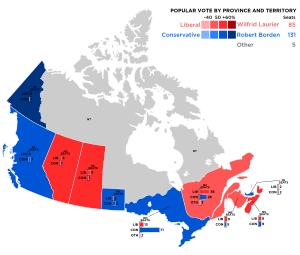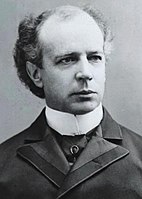| |||||||||||||||||||||||||||||||||||||
221 seats in the House of Commons 111 seats needed for a majority | |||||||||||||||||||||||||||||||||||||
|---|---|---|---|---|---|---|---|---|---|---|---|---|---|---|---|---|---|---|---|---|---|---|---|---|---|---|---|---|---|---|---|---|---|---|---|---|---|
| Turnout | 70.2%[1] ( | ||||||||||||||||||||||||||||||||||||
| |||||||||||||||||||||||||||||||||||||
 | |||||||||||||||||||||||||||||||||||||
The Canadian parliament after the 1911 election | |||||||||||||||||||||||||||||||||||||
| |||||||||||||||||||||||||||||||||||||
The 1911 Canadian federal election was held on September 21, 1911, to elect members of the House of Commons of Canada of the 12th Parliament of Canada.
The central issue was Liberal support for a proposed agreement with the United States president William Howard Taft to lower tariffs. The Conservative Party denounced it because it threatened to weaken ties with Britain, submerge the Canadian economy and Canadian identity with the US, and lead to American annexation of Canada. The idea of a Canadian Navy was also an issue.
The Conservatives won, and Robert Borden became the eighth prime minister. The election ended 15 years of government by the Liberal Party of Wilfrid Laurier.
- ^ "Voter Turnout at Federal Elections and Referendums". Retrieved March 10, 2019.
Cite error: There are <ref group=lower-alpha> tags or {{efn}} templates on this page, but the references will not show without a {{reflist|group=lower-alpha}} template or {{notelist}} template (see the help page).

